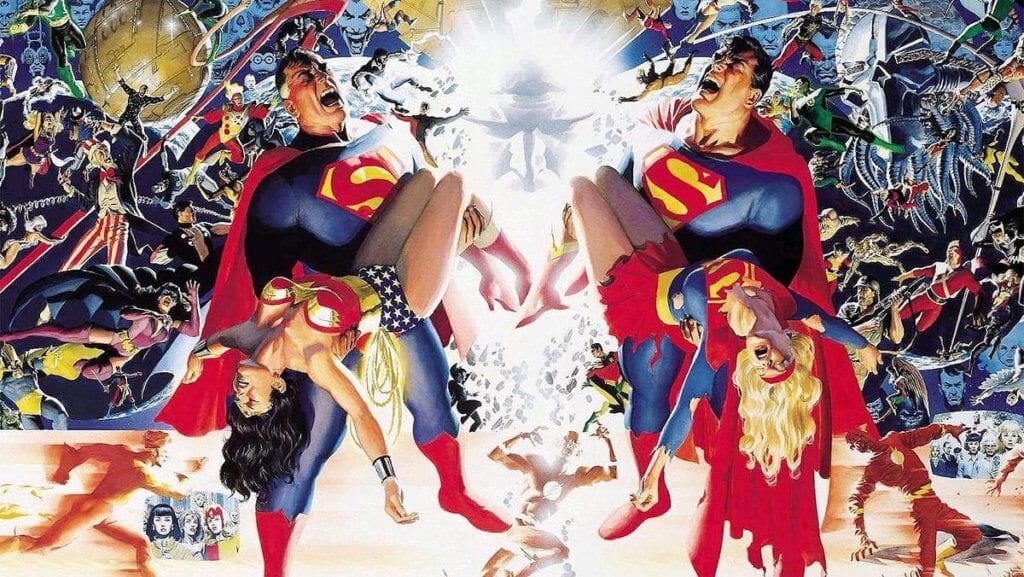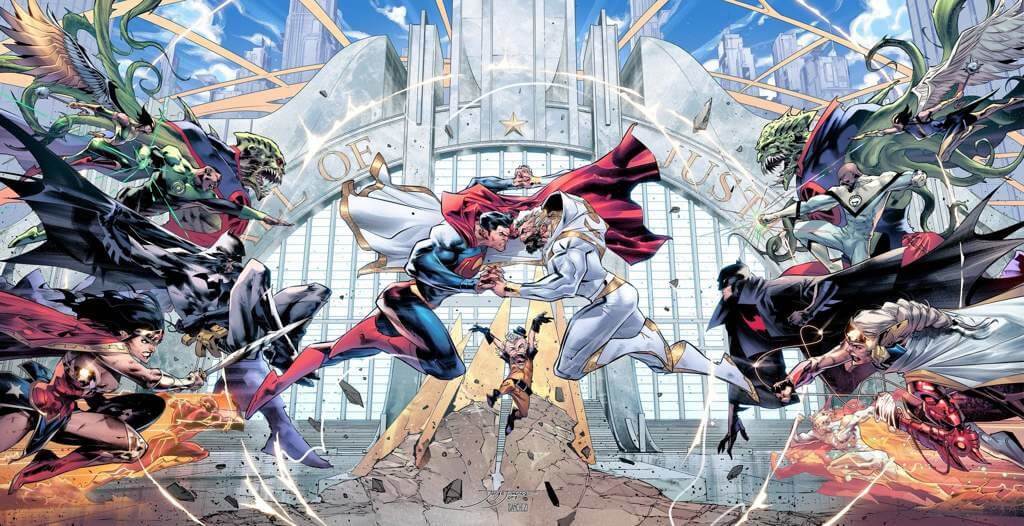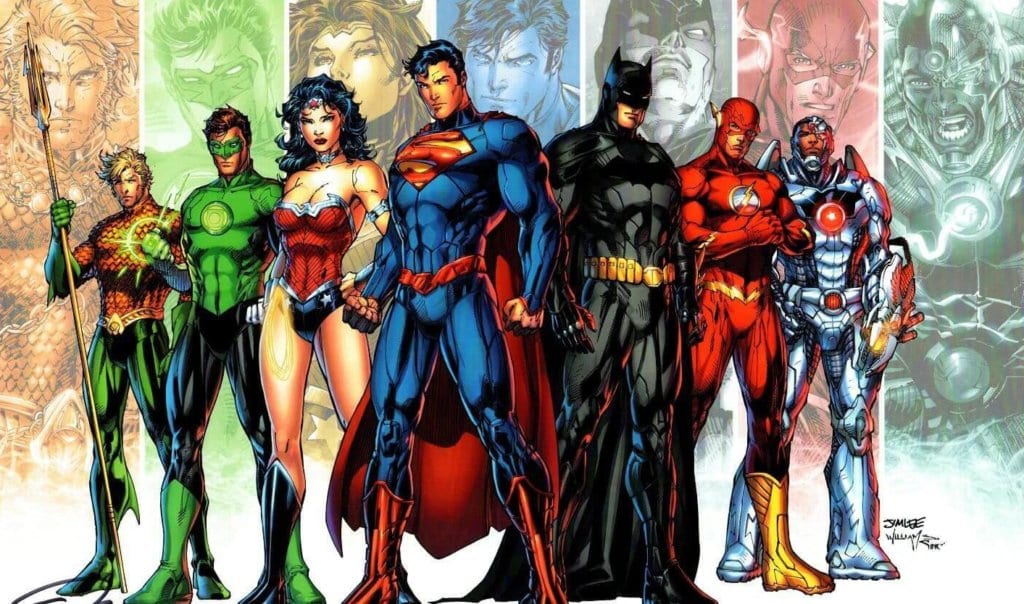DC’s New Relaunch And What It Means
There have been rumblings in the comic book world that DC’s universe is heading for another Crisis-level event. This has been apparent to readers of the current ongoing Justice League, The Flash, Superman, and, most recently, Flash Forward. Without doing a massive anthological recap of Scott Snyder’s current Justice League book, the SparkNotes version is as follows: After the events of last summer’s Dark Knights: Metal and Snyder’s current run on the famed team-up title, the League is pitted against Perpetua. For lack of a better term, we’ll call Perpetua a goddess of sorts. She’s also mother of the Monitors, watchers of the multiverse, and directly linked to the various Crises that have happened throughout the millennia. The League’s conflict with these celestial beings is reaching a tipping point. One such being, called the World Forger, warns the League that a new Crisis is coming, and there’s nothing they can do to stop it. That makes it pretty evident that we’re getting another Crisis event. DC Comics Editor-in-Chief Dan DiDio revealed a new DC Universe timeline and briefly touched on plans for their new “5G” initiative. That’s likely just a code or project name (manufacturers do this all the time), but what it will ultimately be dubbed is irrelevant. What is important is what it actually is and what it means for the DCU moving forward.
I’d like to share a little bit of brief history to catch you up here. DC’s history began in the late ’30s with what is widely known as the “Golden Age.” This was when we were first introduced to Superman, Batman, Wonder Woman, Jay Garrick, Allan Scott, etc. The period that followed was dubbed the “Silver Age.” This was when the Flash and Green Lantern were reintroduced under the holders of Barry Allen and Hal Jordan. Many other new characters were created in that period of the early ’50s and on. Following that was the “Bronze Age” in the 1970s, where many more new characters were introduced. In the 1980s, DC was beginning to feel that their universe was getting far too complicated. So, Marv Wolfman and George Perez brought us the famed Crisis on Infinite Earths event. Yes, the CW is attempting to do this with their Arrowverse shows this season, and yes, it’s going to be an awful shadow of the actual source material – moving on. This reduced the countless alternate Earths they had created over the previous decades down to just one. The idea was to create a much more streamlined DC Universe without so many complicated histories. This was a good idea at that time, to be sure, as it had genuinely gotten out of hand; all those years, the writers hadn’t exactly been writing with a massive, singular continuity in mind. The rub here was that, by reducing their universes down to one, they had also written themselves into a corner. Thus began a slow process of reintroducing multiple Earths back into the DCU.

This culminated in the events of 2005’s Infinite Crisis event, which returned the concept of a “multiverse” back into DC continuity. History repeats itself, especially in comics. As such, in 2011, DC editorial decided that their decades-expanding continuity and history was too much to handle. They had made the comics inaccessible to potential newer readers looking to jump in. As an aside, this may seem like an accurate observation at first glance. However, there are several jumping-off points for virtually every single, important DC character that any new reader could quickly dive into. It just requires the right guiding hand to show them the best place for them. But that is an issue for another day; back to the topic at hand.
And so, with the ideas of a “clean slate” and accessibility in mind, DC rebooted with its famed New 52 line. Launched as a result of the events of the Flashpoint story, this wiped clean the stone tablets of the DC days of yore and started fresh. The idea was 52 books and 52 known universes, so it kept the concept of a multiverse alive. However, as longtime DC comic book fans soon realized, many of these characters were far afield from what they knew. In fact, some of their favorite characters and relationships were nowhere to be found. When the honeymoon was over, the New 52 began to slump, with only a few books maintaining robust sales numbers and being looked back on as good runs. Batman and The Flash were two of the strongest titles in that era and still hold up as great reads to this day. Eventually, DC editorial realized that, while accessibility should be something to be mindful of, it shouldn’t take precedence over the wealth of history and characters that their base knew and loved.
And thus, the 2016 Rebirth event was conceived, which, quite successfully, folded their younger New 52 universe into that of their older pre-52 one. This is a severe oversimplification of what they did, but again, that’s a deeper dive for another swim. The result was an amalgamation of the best concepts of the new and the return of the classic, and it was, to put it lightly, a massive hit. In the last year or so, DC has strayed from the path they were on with Rebirth. We as readers now find ourselves in a spot not at all dissimilar to the one that they put us in just before the New 52 reboot.
As aforementioned, DC’s head honcho, DiDio, revealed their new official timeline and their latest initiative. The idea is to, once again, create space for new readers to jump in. While accessibility is a far stone’s throw away from the only problem facing comics today, it’s a reasonable item to attempt to patch up. That being said, how they go about it will be what determines its grand success or abysmal failure. So what do we know so far? Well, not as much as we’d like to, and that leaves me just the slightest bit trepidatious. I’m not all too fond of DC’s lack of forthcomingness in this matter, as what we do know has a lot of fans on edge. All of this circles back to Dan DiDio’s desire to make everything in DC’s near-century history work together and fit. Famed Flash: Rebirth and Green Lantern: Rebirth artist Ethan Van Sciver once said, “Dan DiDio sees the DCU as a box of a bunch of action figures that he feels HAVE to be organized in a certain way.”
This means that everything centers around this new official timeline that Dan revealed at the New York City Comic Con. That new timeline now begins with Wonder Woman as, chronologically, DC’s very first hero, which kicks off Gen-1, their “Dawn of Heroes.” Gen-2, or “The Space Age,” is when Superman and the lion’s share of the classic heroes start to appear. The events of Crisis on Infinite Earths and everything else leading up to the Flashpoint is encompassed in Gen-3, or “The Crisis.” And lastly, for everything that has happened since the start of the New 52, that would be Gen-4. Generation 5 would be what comes next for the DC Universe, and therein lies the rub. If we are to follow the logic of this new timeline, then how do mortal characters fit in? This timeline, at least as of right now, does not at all fit in with the current continuity. Cue the inevitable Crisis, and likely some Hypertime involvement as well. How is Batman (and other heroes as well) still alive and kicking (literally) all these years later if he was introduced in “The Space Age”? This obviously applies to other Golden and Silver Age heroes too. The prevailing theory is that, through the coming Crisis, these classic heroes will be relegated to the eras that introduced them. Their mantles would then be picked up by new, younger characters. This means that, instead of Bruce Wayne as Batman, we’re getting Luke Fox. In place of Clark Kent as Superman, his son (who has already been ruined by Brian Michael Bendis) Jonathan Kent will be the Man of Steel. The fates of Diana of Themyscira, Barry Allen, Hal Jordan, and other classic Justice League heroes are all yet to be revealed. It is rumored that Keli Quintela, the current Teen Lantern in the Young Justice book, might be Hal Jordan’s replacement as the Earth’s leading Emerald Knight.
At first glance, this Fifth Generation initiative looks like it mirrors Marvel’s “New Age of Heroes”/” All-New All-Different” books. And while this is only based on the information we have about the current plan, it could be a significant problem for the publishing giant, as those aren’t exactly selling like gangbusters. Certain news sites such as comicbook.com and comicsbeat.com have already made hints that much of the already-existing and the inevitable backlash will stem from ugliness (racism, sexism, homophobia, etc.). You know, the usual nonsense that we already-diverse geeks are routinely accused of. This typical venomous diatribe, meant only to stoke fires to further divide an already fractured fanbase, is a false narrative on several accounts.

Firstly, comic fans have always hated their favorite characters getting replaced, regardless of their external characteristics. The Flash is a perfect example of this. Jay Garrick fans didn’t like Barry Allen at first. Likewise, Barry Allen fans weren’t initially fond of Wally West replacing him after Crisis on Infinite Earths, just as his fans weren’t of Bart Allen’s (very brief) run as the Scarlett Speedster. Further examples include Dick Grayson fans not liking Jason Todd (and let’s be 100% here; nobody liked Jason Todd until he was Red Hood) and Batman fans not being overly fond of Dick donning the cape and cowl. This is to say nothing of Azrael doing the same during the Knightfall arc. Secondly, we’ll use the Green Lanterns as an example, as there has been a wide range of characters who have borne the emerald ring of Will. Alan Scott, Hal Jordan, John Stweart, Kyle Rayner, Jessica Cruz, and more are all visibly different characters that have strong followings and have been well-received. So while comicbook.com can condescendingly say things like,
“…some fans who are critical of introducing a more diverse cast of characters into superhero comics will claim that their real complaint isn’t with diversity itself as much as attaching the new characters to existing brands.”
Or comicsbeat.com spouting foolish things like,
“So far, the reaction from fans online has been wildly predictable, listing (of course) toward negative. The two major lightning rods for outrage have been continuity-tinkering and replacing heroes, both of which have fraught and complicated histories among wide segments of people who consume weekly superhero comics, the reasons for which can sometimes be downright ugly.”
This sort of false narrative only serves to show these writers’ own ignorance and prejudice. Geeks and comic book fans, especially, and “diversity” are natural concomitants of one another. These identity politics and moral preening-obsessed writers are ignoring the voices of every single non-white-male fan out there who shares the exact same gripes with changing characters needlessly. Eric July, a popular comic book and political YouTuber, has a lot to say about the tokenization of existing heroes instead of building upon the already-existing litany of excellent characters who also happen to be minorities, or creating new ones and building new legacies around them. It’s lazy, it’s insulting, and it cheapens the characters because it reduces, “Why should someone buy your comics?” (or maybe more accurately parent company AT&T asking “Why do we need to keep you?”) to “Because… umm… our Batman is black!”
Ultimately, we won’t know what the end result will be until we see it. And while I leave room for this “5G” idea to work out, current year and recent attempts at the same (or similar) thing give me pause. The last time DC wiped the slate clean or rebooted resulted in my favorite character getting erased from the multiverse entirely. On paper, I think the idea is good. But I feel that it will be ultimately unnecessary. Sticking with and getting back on track with their Rebirth initiative would be the far better play in the long run.








